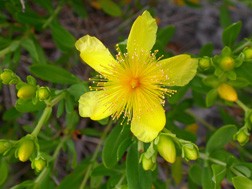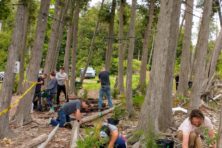Jackson Harbor Ridges – Island Gem
- Share
- Tweet
- Pin
- Share

Seeing the lovely Sticky Triantha is worth a trip to Jackson Harbor in early July. Photo by Roy Lukes.
Many years ago, sometime in the mid 1960s, I came to know a couple from Racine, Bob and Louise Erickson. They were camping at Toft Point and joined me on several of my guided hikes at The Ridges Sanctuary at Baileys Harbor. Louise was deeply interested in birds and wildflowers, along with nature in general, and was especially fascinated with areas that had been preserved, which is why she was so strongly lured to Toft Point and The Ridges Sanctuary.
The Ericksons owned a small cottage at West Harbor on Washington Island, Louise’s birthplace, and she spent many hours exploring the island enjoying nature. It was during one of her hikes with me in The Ridges that she described a similar ridge-swale formation area at Jackson Harbor on Washington Island that she felt had many similar wildflowers and nesting birds. I clearly recall her firmness in telling me that, ecologically, it was a very special place that needed preserving. The one item which was sorely needed was the money to purchase the undeveloped property, and there began her several-year mission which led to the eventual purchase and establishment of the Jackson Harbor Ridges.
On one occasion Louise arranged a meeting in Oshkosh with several state legislators. Percy Johnson, then the chairman of the town of Washington (Island), Louise and I spent several hours convincing the legislators of the great scientific, scenic, and natural history value of the Jackson Harbor Ridges and why state money was needed to preserve it for the public. Eventually this was approved, and several years later the Wisconsin Chapter of The Nature Conservancy added to the property by purchasing the southeastern tip of this valuable ridge-swale area including Carlin’s Point.
The 70-acre Jackson Harbor Ridges became a Wisconsin State Natural Area in 1973, affording it extra long-range scientific recognition and protection. Today the 12 ridges and swales and broad beach area support an exceptionally rich flora of rare and uncommon plants. Two federally threatened plants, the Dune Thistle and Dwarf Lake Iris, grow here along with the state-threatened Dune Goldenrod.

The Jackson Harbor Ridges lie at the west side of the bay in the middle of the photo. Photo by Roy Lukes.
Charlotte and I recently spent two glorious days on Washington Island. On Friday night, Sept. 2, Charlotte presented her new mushroom program to a large enthusiastic audience. The following morning I led 20 people on a tour of the Jackson Harbor Ridges and that afternoon Charlotte led a hike for 17 islanders searching for mushrooms in privately-owned woods. Both hikes and the evening program were organized by the Island Art and Nature Center.
Every time I hike at the Jackson Harbor Ridges, entirely owned and well-managed today by the Town of Washington, I momentarily pause in thanks near the gate where a small monument commemorating Louise Erickson stands. What a tireless worker, fighter and role model she was! A light steady rain soon stopped, all the plants appeared refreshed, the temperature was perfect and interest ran high.
I especially wanted the group to get to know one of the rather insignificant plants that is common along the wet, hard-packed shore at the ridges – it blooms around early July and goes unnoticed by most people – the slender, 12- to 15-inch-tall False-Asphodel or Sticky Tofeldia. It’s one of those plants that doesn’t “jump out at you.” I strongly dislike the “false” name, and the old genus, Tofeldia, has been changed, so today I call it the Sticky Triantha (tri-AN-tha), its new generic name. Even in its late season seed stage the stem is quite sticky. During the period of flowering it’s quite beautiful, especially when viewed through a hand lens.
Two plants at the peak of their blossoming stages decorated the shore by the thousands, the Kalm’s Lobelia and the flat-topped Ohio Goldenrod, a flower of special concern in Wisconsin. The abundance of both plants in very specific narrow zones along the shore indicates that they like it there. Another downright gorgeous goldenrod, the Dune Goldenrod, with deep red stem, quite tall and stately, and often growing in bouquet-like clusters of several stems, is threatened in the state and is confined to very specific dune areas especially in Door County. It does very well here.

The many stamens of the Shrubby (Kalm’s) St. Johnswort appear to explode from the center like miniature fireworks. Photo by Roy Lukes.
Two other wildflowers, the Smaller Fringed Gentian and False Foxglove, were just beginning to bloom and will soon be at the peak of their fall beauty. It is in these out-of-the-way protected areas, far from the crowds, that these very special plants do so well. Both thrive in damp sandy sites and like their feet on the wet side. Another sparkly little native shrub that blooms in mid-summer, the Kalm’s (Shrubby) St. Johnswort, was commonly seen during our outing.
Most of the people on the ridges hike were also at Charlotte’s mushroom program the evening before so were naturally on the lookout for any and all they could find. As unlikely as it is to come upon fleshy fungi in sandy areas, there are a few occasionally to be found. These islanders were great fun to be with because very little escaped their notice. One of the “sharp-eyes,” Melody Walsh, located several very tiny puffballs growing in the damp sand dune and took some excellent pictures of the three-quarter-inch specimen. After a complete study of the mushroom at home, including microscopically examining the spores’ color, shape, and size, Charlotte declared it to be a brand new species for Door County, the Buried-stalk Puffball.
Every adventure-packed nature trip we experience at Washington Island leaves us yearning for the next. The botanical treasures at the Jackson Harbor Ridges rank near the top on our list of favorites in the Upper Midwest. When you do visit this precious gem, treat it with great respect. Put your feet down as rarely as possible.


